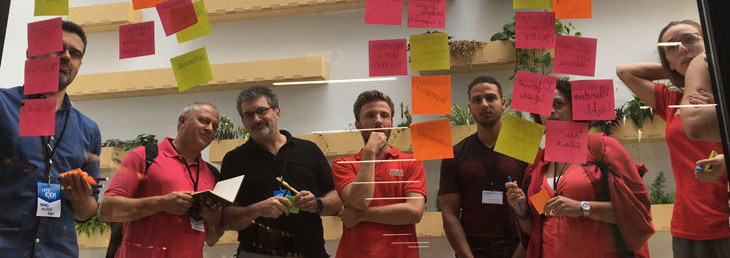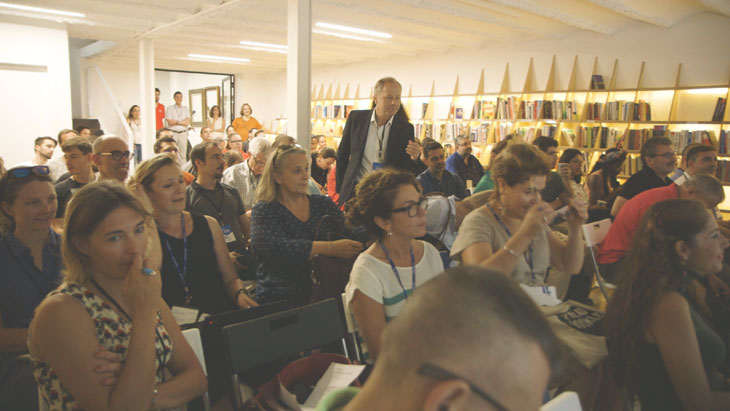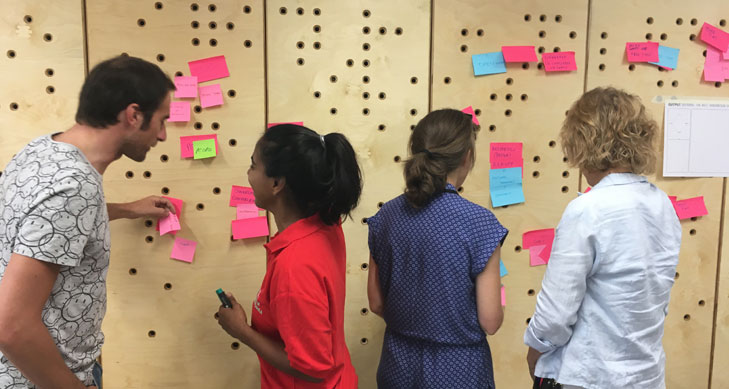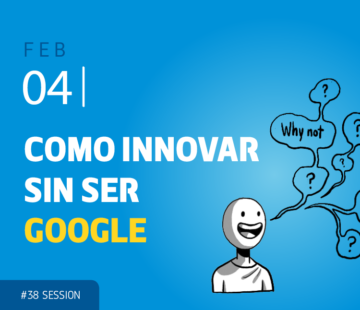#29 Co-session (II): Defining the best innovation space

The opening of our new premises gave us the idea to appropriately dedicate our Co-Session #29 to the subject of spaces for innovation. Besides the first person accounts from three people from different organizations on how their respective companies have addressed the issue of new spaces for corporate creativity, we also wanted all attendees to participate in a collective design of the features than an ideal space for innovation should or could provide.
But first we had too the opportunity to learn from different experiences and real cases on the state of the art regarding creative and innovation spaces. Alfons Cornella, founder of Co-Society, showed us some trends and examples of new workspaces around the world. We learned that workspaces have undergone a major transformation over recent years. In the 70s and 80s, a typical corporate office had dozens of employees isolated from each other, each in their own cubicle. Thirty years later the opposite is the order of the day, with totally open spaces that strip away any feeling of privacy and even hierarchy. But now, even this model of a workspace that is so in vogue is a subject of hot debate as it is considered counterproductive in the case of some jobs and types of workers.
He concluded that the ideal and definitive place for creativity and innovation has yet to be found, and that perhaps the best way forward is to offer spaces that are easily adaptable to the needs of each moment and context. We also learned that the corporate space is no longer the only possible option anyhow, and that nowadays new workspaces are expanding into increasingly varied ways of relating to other people: co-working spaces; spaces for Makers and doing things with our hands (FabLabs); combining work and personal life; working from time to time on a particular challenge with creatives “in residence”, etc.

Workshop: Defining the best innovation space
Divided into several working groups in which the Co-Society Fellows were able to do joint creation with the students of the Summer School on Management of Creativity, the time came to put into practice what they had learned and to contribute their own ideas on the day’s theme. The goal: to design an ideal space for creativity and innovation. The rules: just one, to consider four key elements: The space itself, of course, but also the time or times to be creative; the type of people or group of people involved in the innovation and, finally, the materials and tools to be used.
As is to be expected considering the large number of creative profiles taking part in this workshop, the ideas proposed included several interesting concepts, such as the use of music and sounds to get people into the right mood, or the configuration of the creative space following the metaphor of time of the day and its different biorhythms. There was also a considerable amount of agreement, such as the need to make time for innovation a time outside the run-of-the-mill and the “mindset” used for day-to-day tasks.

Results of the Workshop: Six prototypes of new spaces for innovation
ZEN STETIC. Inspire yourself by feeling Nature and fostering the connection between Body and Mind. Find a way to create your own space to innovate and be creative depending on the goal and how you feel at each moment. Visualize ideas combining the use of all types of physical and digital elements. Take advantage of your energy at the weekends by devoting time to innovating and being creative on Monday mornings. Promote a variety of ages, genders, nationalities, profiles and professional experiences.
SENSORY SPACE. A sensory space that encourages interaction with people and thinking “outside the box”. Time: Once a week, outside traditional working hours. For example, at night and in a relaxed or leisure environment.
METAPHOR OF TIME. Space and time organized according to the metaphor of time throughout the day. There would therefore be an “Awakening” area and/or time dedicated to the first triggering of ideas. A “Lunch Time” area where the aim would be to try to “feed” these ideas and share them. The “Afternoon” area would be the place and time to put ideas into practice, an area in which to stop thinking and start doing (prototypes, etc.). Finally, a “Night” area would be where you could meditate ideas, “consult with your pillow/sleep on it” or explain ideas to and interact with people other than those you work with in the office for the rest of the day.
THE COCKTAIL. A space to offer a mixture of flavors: an area for inspiration, another linked to knowledge with a library/media library, another as an open space to connect with the air and be able to look directly at the sky, feel the outside temperature, etc.
ROOM ON DEMAND. A space that can be adapted to the needs of all types of creative or innovation process in which different elements are always included, such as relaxation through leisure, the use of sounds to create the most suitable moods for each occasion or encouraging interactions with people outside the organization itself.
S.P.A (Space to Put in Action). A space that mainly focuses on “learning by doing” in which we must be able to prototype the most diverse ideas to capture important insights in the process. Connectivity must also be a very important factor for this space to be above all a space to share ideas and receive feedback on them. S.P.A. must be a space where any moment provides an opportunity to learn and create.
